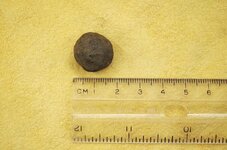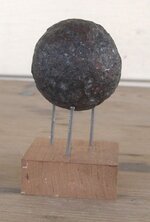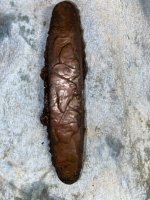This was found 30 centimeters in the ground in Compton, California. It was found near the Rancho Dominguez Adobe Museum. It is part of an ongoing excavation. I thought you all might have seen something like this before and could provide some useful information. It is 98% Iron with some other trace elements.
There was a battle during 1846 in this area that did involve a 4-pounder cannon used by the Californios against the Americans. Is it possible that this is iron shot used in a cannon? How could I tell if it is a ball bearing or iron shot (possibly makeshift).
Here is a photo showing the metric size.

Any information would be helpful!
Thank you
There was a battle during 1846 in this area that did involve a 4-pounder cannon used by the Californios against the Americans. Is it possible that this is iron shot used in a cannon? How could I tell if it is a ball bearing or iron shot (possibly makeshift).
Here is a photo showing the metric size.

Any information would be helpful!
Thank you

Amazon Forum Fav 👍
Upvote
1





